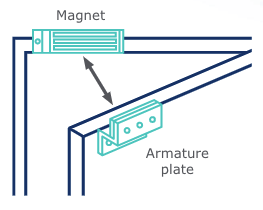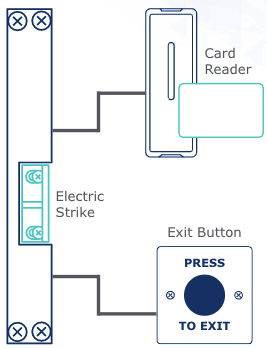SM500
Surface Mount Maglock (1,100 lb)
Scroll to learn more
Let’s start simple. Locks are devices that secure a door or entryway in order to control which individuals can gain access. There many different types of locks in the world, each with its own advantages and disadvantages. Most people are familiar with mechanical locks, like the ones used on the exterior doors of houses. These are controlled by a physical key or lever which release a mechanism inside the lock.
Meanwhile, electronic locks are controlled by electric current. There are 3 types of electronic locks which to secure the door in different ways. These include magnets, metal catches, and motorized bolts.
There are many benefits to using electronic locks instead of mechanical locks. For starters, as there is no physical keyhole in an electric strike or magnetic lock, it cannot be picked. Electronic locks are also automated, whereas someone must remember to secure a traditional lock, leaving a greater potential for human error.
Electronic locks are designed to be used with access control systems. These might be online or standalone systems. The primary benefit of access control is that it makes it simple to ensure that only authorized people can enter restricted areas. It is expensive and time-consuming to cut new keys for every person who needs one, and difficult to keep track of who has which keys. With electronic locks and an access control system, users and their credentials can be easily added, changed, or removed.
Another benefit is the monitoring and visibility electronic locks offer. When a door is opened by a traditional lock and key, there’s no way to tell who used it and when. Electronic locks can be monitored, and an event log maintained to track exactly who is going in and out of areas at particular times.
There are three main types of electronic locking devices:
Each uses a different method to hold the door secured. Each has its own advantages and disadvantages and different locks are better suited to different doors and buildings.
Maglocks consist of two main parts: an electro-magnet and an armature plate. The armature plate is attached to the door leaf itself, while the magnet is attached to the door frame. When power is applied, and electric current runs through the circuit, the magnet turns on and creates a powerful magnetic field. The armature plate is strongly attracted to the magnet, and this attraction force holds the door closed. When power is removed, the magnetic field drops and the door can be opened.
Electro-magnetic locks are particularly suited to emergency exits and fire doors which have to allow free egress in an emergency, and glass doors which cannot have electric strikes fitted.

Electric strikes consist of two main components: a powered latch and a faceplate. Strikes come in both fail safe and fail secure models, which behave differently when power is turned on or off.
The strike’s faceplate is fitted into the door frame and catches the powered latch or bolt which is fitted into the door leaf. When the strike is activated by either the application or removal of power, it flicks back to release the latch or bolt from the door and allow the door to open.
Strikes are useful in a number of contexts where other types of lock are not suitable:

Electronic locks can be either fail safe or fail secure. Electro-magnetic locks, tend to be fail safe by nature. Others, like electric strikes, may be one or the other or adjustable depending on the needs of the project.
Fail safe means the lock opens when power is turned off. Fail safe locks are mainly used to ensure safe egress in an emergency. In the even of a power outage the door will open freely and allow people to exit.
Fail secure means the lock opens when power is turned on. In the event of a power cut, the door will therefore remain locked and keep the assets inside protected.